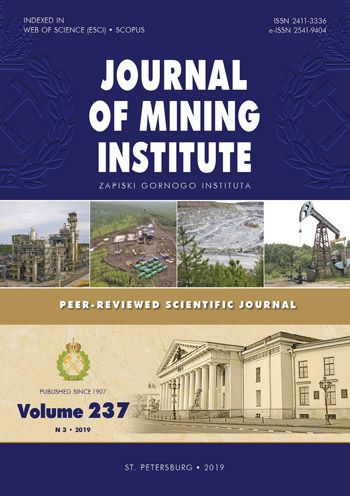Thermodynamic model of ion-exchange process as exemplified by cerium sorption from multisalt solutions
- 1 — Ph.D., Dr.Sci. Head of department Saint-Petersburg Mining University
- 2 — Ph.D., Dr.Sci. professor Montan Universität Leoben
- 3 — Postdoc in metallurgic processes K1-Met GmbH
- 4 — Ph.D. Assistant Lecturer Saint-Petersburg Mining University
Abstract
A complex heterogeneous process of ion exchange can be defined with an isotherm-isobar equation of the chemical reaction, which describes differential affinity between the process and its effect – the law of mass action. Ion exchange includes processes accompanied by changes in the charge of ions and functional groups caused by the passing of ionic bond into covalent one. Hence isotherm equations of ion exchange for such processes must differ from conventional stoichiometric equations, but they can be obtained by classical study approaches to ion exchange equilibrium. The paper describes a new thermodynamic model, based on linearization of mass action law, modified for the ion exchange equation. The application of this model allows to define stoichiometry of ion exchange and the shape of ions adsorbed by the solid phase of ion-exchange resins, as well as to estimate equilibrium constant and Gibbs free energy of the process. Comparative analysis has been carried out for the thermodynamic model of cerium sorption in the form of anionic complex with Trilon B from a multisalt solution with ionic strength of 1 mol/kg (NaNO3) under рН = 3 and temperature 298 K on a test sample of weak-base anion-exchange resin Cybber EV009. Experimental isotherm of the sorption has been obtained. Calculations of thermodynamic parameters have been performed using Langmuir, Freundlich, Dubinin – Radushkevich, Temkin and Flory – Huggins models, as well as thermodynamic model of linearized mass action law, proposed by the authors. Calculated values of the equilibrium constant and Gibbs energy – K = 9.0±0.5 and ΔrG0298 = –5.54±0.27 kJ/mol – characterize the sorption of EDTA cerate ions by ion-exchange resin. The shape of adsorbed ions has been defined in Stern-Helmholtz layer of CeTr, and total capacity of anion resin EV009 for EDTA cerate ions has been estimated as q∞ = 2.0±0.1 mol/kg.
Funding
This research has been performed in the framework of project N 19-19-00377 «Background Technologies of Extraction and Selection of Strategic Rare Earth Elements from Apatite Products» from 22.04.2019, supported by the Russian Science Foundation in 2019 contest «Basic Scientific Research and Exploratory Scientific Research, Conducted by Individual Research Teams»
